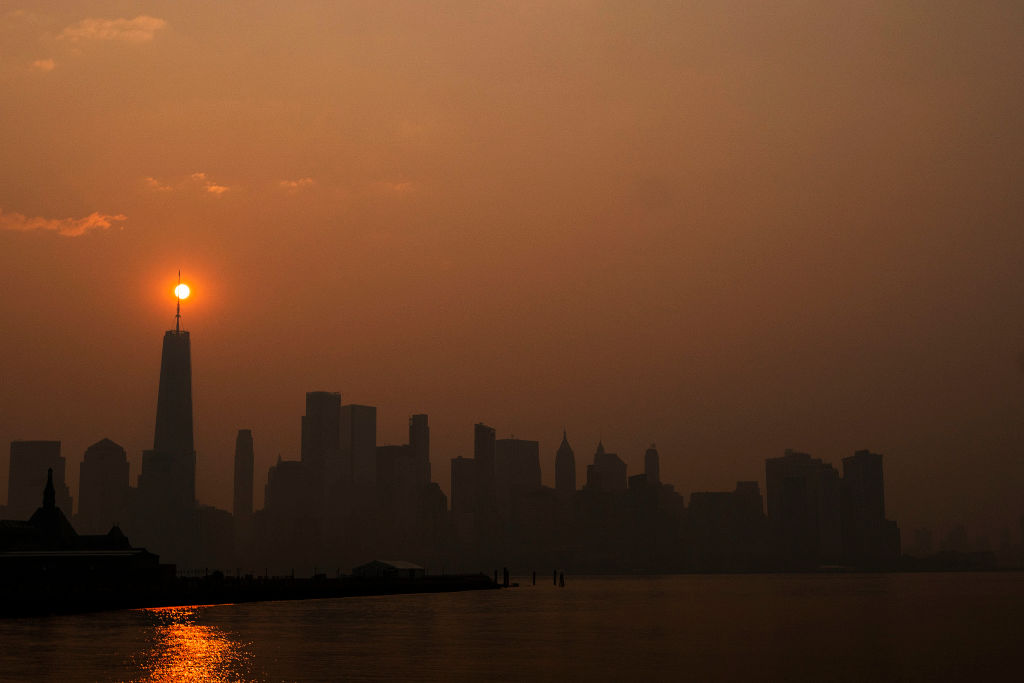Is the hazy stuff out there smoke billowing down from Québec, or hot air emitted from smoggy-brained politicians and journalists? Chuck Schumer told the Senate on Wednesday that the smoke drifting over the Eastern Seaboard was caused by climate change. Alexandra Ocasio-Cortez said it showed the urgency of going greener faster. Proof of carbon pollution, lectured the Canadian minister of the environment. A stark reminder of climate change, intoned Biden.
Every news organization and weather app out there suddenly became experts on a new hazard — not smoke or fire, well-known phenomenons that have been extensively documented throughout history — but a new threat, both more nebulous and more ominous: “air quality.” Electronic devices and weather stations began making unsolicited “air quality” reports. The New York Post made melodramatic comparisons with the aftermath of 9/11. Other outlets published analyses of the health risks of smoky air for pets and those in vulnerable states of health. The CBC, Canada’s state broadcaster/doomsayer, assured everyone who would listen that “air quality warnings are likely to become more common with climate change.” Climate change? Or social change — to be imposed via radical environmental policy? And what’s next, “air quality” sirens that urge you to duck for cover when a diesel vehicle rolls by?
The fires in Québec and Ontario are real — especially for those forced to evacuate their homes. So too is the unpleasantness of smoke blowing across eastern Canada and the United States. And just as real, unfortunately, is the propensity of politicians and their media cheerleaders to capitalize on human suffering in order to move society in their preferred direction: in this case, the fool’s gold of net-zero emissions.
But Canadian wildfires aren’t caused by emissions. Wildfires are as normal as thunderstorms. They form part of the natural life cycle of North American forests. While of course some fires are caused by human carelessness or arson, most of the fires currently ravaging Québec and northeastern Ontario are believed to be caused by lightning. Hate to shock the climate zealots, but lightning has been starting forest fires since long before the Romans began using fossil fuels to heat their baths in early Britain.
;768:[300×250,336×280,320×100];0:[300×250,320×100,320×50]”]Spruce and pine forests, like the enormous ones spreading over northeastern Canada, are particularly susceptible to fire as they grow older. The trees grow ever more closely together, preventing light from reaching lower vegetation and branches, which die, dry out and then choke the still-living trees. Once enough dead brush and branches accumulate, it only takes a stroke of lightning in the right place for the forest to burst into flame.
Dying forest areas are thus cleared by fire, after which the vegetation returns. Plants driven underground regrow. New trees spring up. Invasive species and forest pests are reduced, while native species come back and flourish. Some kinds of seeds, such as those of the jack pine, actually require the stimulation of flame to break open and will only germinate in the aftermath of a wildfire.
While these fires are serious threats to human activity in the area, they benefit the ecosystem, and Canadian forest management practices are now taking into account the value of controlled burns, especially near inhabited areas, in order to achieve the benefits of wildfires while limiting the dangers. Lightning is actually less likely to start fires in logged forests, where brush is regularly cleared away and mandatory tree replanting allows space for new growth.

None of this is to deny or downplay the real threats and impact of fire and smoke to human life. But when our politicians start claiming that an entirely natural cycle that has been going on for centuries is a consequence of irresponsible human behavior, it’s time to throw the science book at them. It’s not climate change — it’s climate sameness. The tides rise and fall, it’s cold in the winter and warm in the summer, and lightning strikes dry brushwood and starts forest fires, sometimes more often and sometimes less. We puny humans do not control these things, despite officials with delusions of grandeur who believe some action of theirs could possibly determine the temperature of the planet, alter the direction of the wind, or regulate the level of the seas.
It might also be a good time to remind everyone not to worry so much about the health impacts of wood smoke. Our ancestors lived for centuries upon centuries in dwellings heated by wood fires — to the extent that fireplaces and smoke curling out of chimneys communicate home, family and civilization on a level so fundamental that our very bones know their meaning. If our ancestors hadn’t survived this smoky regimen, we wouldn’t be here. And they didn’t wear masks to protect themselves from the smoke, as governments are now hysterically recommending — what is it with this undying mask obsession? — and yet, somehow, the human race continued on.
;768:[300×250,336×280,320×100];0:[300×250,320×100,320×50]”]And most importantly, how about a little perspective? Why are we spending all this time complaining about “air quality” in New York City, when there are real families in Québec abandoning their homes and livelihoods to escape actual, life-threatening flames?
Enough with the manufactured drama. New Yorkers are going to be OK. Residents of Val d’Or, Québec — well, maybe not.

























